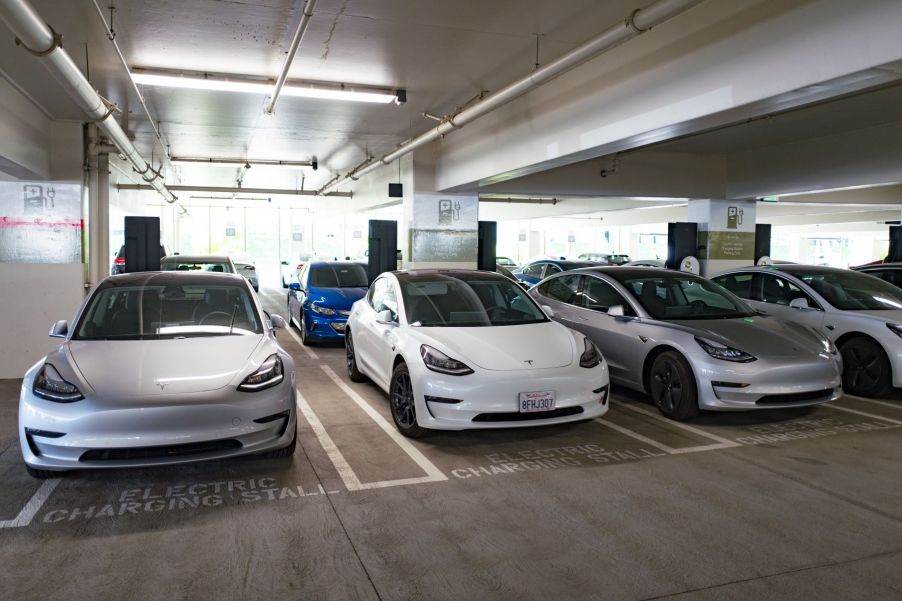
It Takes 12 Hours to Fully Power up This Electric Car With the World’s Worst Charging Time
Electric vehicles are gaining mainstream momentum thanks to their decreasing prices and increasing battery charges. However, many EV buyers aren’t sure how to assess charging times. People have been calculating miles per gallon (mpg) their entire lives and aren’t sure what reasonable EV specs might be. This may be why many people assume that Tesla is the gold standard of electric vehicles, but it’s not.
One Tesla model takes 12 hours to charge, which is the worst charging time for a mass-produced EV. So, what is a good timeframe for battery charging? Some EVs will fully charge in 30 minutes. Others could take up to 4 hours. Still, others might take 10-11 hours. A few factors come into play when figuring out how long it will take to charge your EV’s battery.
What are the different EV charging levels?

There are three levels of power that can be used to power up an EV battery. A trickle charge is the slowest. It is the kind of charge delivered by a Level 1 power source, typically a 120V residential outlet. It can take as long as 40 hours to fully charge an EV battery with this source. Trickle charging is generally used by people who have short work commutes and don’t need hundreds of miles worth of electric driving range. They plug in overnight and have enough power to get to the office and back.
Level 2 power sources can be found in both residential and commercial settings. At 240V, these outlets can power refrigerators, water heaters, and EVs, though not simultaneously. NeoCharge has developed splitters that can be installed on existing residential 240V outlets, but typically a 240V charging station home installation requires an electrician. Depending on your vehicle’s battery and additional specs, a 240V source will deliver 12-30 mph of driving time per hour of charge. In other words, at Level 2, your battery will recharge within 6-12 hours.
Lastly are Level 3 power sources, which are most commonly known as DC Fast Charging. Using 480V, most vehicles can charge up to 80% within only 30 minutes.
The Tesla Model 3 and Model S charge slowly when using Level 2
According to Kelley Blue Book, it takes the Tesla Model 3 and the Tesla Model S 12 hours to fully charge when using Level 2 charging. So, is Tesla lying when it says its vehicles can power up in as little as 30 minutes? Not exactly, but it isn’t saying that it takes a Level 3 power source to charge a Tesla battery that quickly.
So, what can you make of this when you are choosing a vehicle? Don’t let the specs fool you. The charging times are approximated based on how long it will take to load a battery off a 240V Level 2 power source, the default power source for EV chargers.
Kelly Blue Book provides a few examples of typical 2021 model charging times with a Level 2 source.
- Mini SE Hardtop – 4 hours
- Polestar 2 – 8 hours
- BMW i3 – 7.5 hours
- Chevrolet Volt EV – 10 hours
- Nissan Leaf – 11 hours
- Tesla Model 3 – 12 hours
- Tesla Model S – 12 hours
However, while the Tesla Model 3 and Model S may take longer to recharge using a Level 2 power source, they have the additional benefit of having more electric driving range than most of its competition, such as the Chevy Bolt and Nissan Leaf.
How can you power up your EV faster?
So, what can you do with your Tesla (or other EV) so it doesn’t take several hours to fully power up? The answer is simple, as you need to use a Level 3 power source for when you need to recharge your electric vehicle quickly. With DC Fast Charging stations at 480V, you can power up your EV with speedy results. Voltages that high mean that you can spend minutes “refueling” instead of hours.
If you pull into an Electrify America or EVgo station, then you can plug in and power up while you get a cup of coffee. When you return, you will be ready to go. However, there are a few things to consider before using a 480V station. First, charging your battery at a fast rate can degrade your battery faster than using lower voltage power sources. Additionally, charging your battery to full capacity will degrade your battery. Like cell phones, it’s best to get the battery to 80% and never allow it to go lower than 20%.
So, be aware that when you’re charging your EV at home, it will take quite a bit longer to fully power up than at a Level 3 power source. You might also want to have an electrician modify the outlets in your garage to upgrade it from a Level 1 to Level 2 power source for faster “refueling” times.


